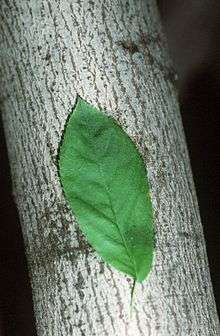Amelanchier laevis
| Amelanchier laevis | |
|---|---|
 | |
| A. laevis leaf and bark | |
| Scientific classification | |
| Kingdom: | Plantae |
| (unranked): | Angiosperms |
| (unranked): | Eudicots |
| (unranked): | Rosids |
| Order: | Rosales |
| Family: | Rosaceae |
| Genus: | Amelanchier |
| Species: | A. laevis |
| Binomial name | |
| Amelanchier laevis | |
| Synonyms[1] | |
|
Synonymy
| |
Amelanchier laevis (commonly known as the smooth shadbush, smooth serviceberry, or Allegheny serviceberry) is a North American species of trees in the rose family, growing up to 9 metres (30 ft) tall. It is native to eastern Canada and the eastern United States, from Newfoundland west to Ontario, Minnesota, and Iowa, south as far as Georgia and Alabama.[2]
Description
Amelanchier laevis has stems of 1–15 metres (3 ft 3 in–49 ft 3 in) or 2–17 metres (6 ft 7 in–55 ft 9 in) which are growing in small clumps. Its petioles are 12–25 millimetres (0.47–0.98 in) with green blades which are elliptic and almost ovate. The leaves have 12–17 lateral veins and 6-8 teeth per cm. The fruit, which are pomes, are edible and can be eaten raw or cooked. The fruit has a sweet flavor. The bark can be made into a herbal medicine for expectant mothers. It is a deciduous tree. It is cultivated as an ornamental shrub.[3][4][5] The cultivar 'R.J. Hilton' has gained the Royal Horticultural Society's Award of Garden Merit.[6]
References
- ↑ The Plant List, Amelanchier laevis Wiegand
- ↑ Biota of North America Program 2014 state-level distribution map
- ↑ "Amelanchier laevis". University of Maine. Retrieved February 10, 2008.
- ↑ Wiegand, Karl McKay 1912. Rhodora 14(163): 154–158 diagnosis in Latin, description and commentary in English
- ↑ Wiegand, Karl McKay 1912. Rhodora 14(163): plate 96, figures 7A-7G line drawings of leaves, fruits, and flowers of Amelanchier laevis
- ↑ "Amelanchier laevis 'R.J. Hilton'". Royal Horticultural Society. 2017. Missing or empty
|url=(help);|access-date=requires|url=(help)
External links
- Amelanchier laevis, Plants for a Future
- photo taken in Virginia by David Stang, showing flowers of Amelanchier laevis
![]()
![]()